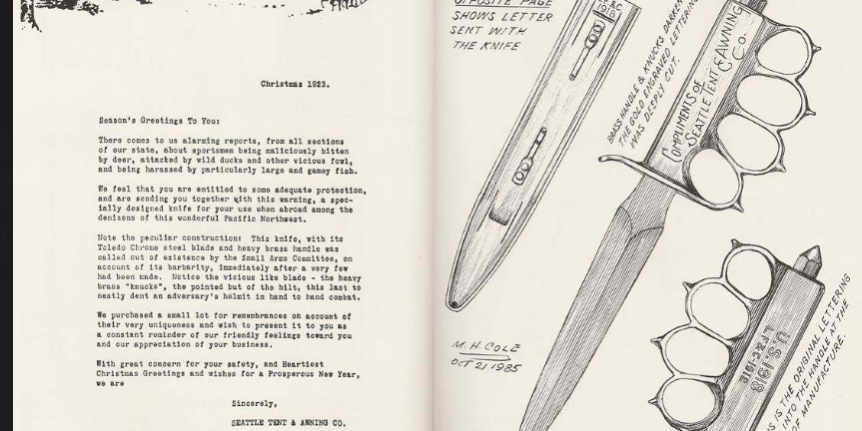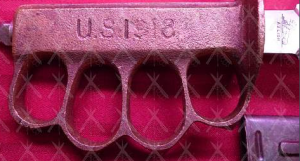If you are a knife enthusiast, you are likely to collect or look for vintage knives. And if you are interested in combat knives, the 1918 trench knife will surely be on your preference list. So, whether you want to buy or sell a trench knife, the first thing you need to know is how to tell if a 1918 trench knife is real or not. Otherwise, anyone can con you with the price or misinformation.
There are some shady collectors or manufacturers who sell fake knives at an expensive price. And as the replicas look similar to the real models, it can get confusing to identify the real ones. But don’t worry, we are here to walk you through the methods of identifying the real trench knife. How Many Variants of 1918 Trench Knife Are There?
Before you learn how to distinguish the real 1918 trench knife from the fake one, you should be familiar with its variants. Because some variants were never issued to be used in combat whereas others made it to the battlefield.
So, if you are mainly looking for the issued 1918 trench knife, here is what you need to keep in mind –
- The HD&S is the first-ever variant of the 1918 trench knife. However, after the field test of this variant, this one could not make it to combat. It was not issued to go to war as the variant needed some improvements. So, if you want the real issued knife, there are other variants to concern yourself with.
- The AU Lion Type grooved and ungrooved trench knives are the real and issued variants.
- The L.F. & C. type (Landers Frary & Clark) is the issued U.S.-made variant of the trench knife.
Now that you know which variants to look for and which to avoid based on your purpose, let’s get started with the dating process of the real trench knives.
What Are the Methods to Tell If a 1918 Trench Knife is Real or Fake?
There are many reproduced and artificially aged variants of the 1918 trench knives. So, it gets tougher for collectors or knife enthusiasts to identify the vintage ones. But with the methods described below, you can identify the real ones –
- Online Forums and Books
Fortunately, there are online forums solely for discussing various knives and wartime objects. If you post a picture of the knife on those forums, especially the military forums, experts and professionals right there will help you identify the real knife. However, if you do not have a picture, you can post the details of the knife and you will probably get help.
But if you cannot fully trust the forums, we recommend getting knife collectors’ books or guides to help you identify. The US Military Knives Bayonets & Machete Book IV is one of the go-to books to get more insights into the 1918 trench knife. You might find a free copy of the guide online. Here is a reference page from the book mentioned:
- Company Trademark and Markings
As mentioned, two common real variants are the Au Lion and the L.F. & C. ones. The real Au Lion type knives come with the Au Lion name stamped on the ricasso of the trench knives. The Au Lion trademark or name is slightly lighter in color on the ricasso as shown in the picture:
And the real L.F. & C. variants come with the stamped “L.f. & C.” name on the knife’s handle. The trademark is deeper in color as shown in the picture below:
Note that the real Au lion variants have several markings on the blade. But the L.F. & C. ones do not have such markings. And the trademarks on both real variants are in the centered position. But the trademarks on replicas look positioned to one side.
- Identify the Fronts
The real trench knives have deeply carved “U.S. 1918” fronts on the handle. But the fake ones are not too deep to look at.
Also, the vintage and issued knife fronts have a smoother finish. But the fake ones have roughly finished fronts on the handle. Here is a picture to compare these. The left side of the image represents the original trench knife front
- Expensive Pricing
Any vintage objects, especially wartime ones, are expensive in their prices. You can find trench knife replicas at $21 to $100 bucks.
However, the real 1918 trench knife owners do not sell at such a lower price. The original variants’ prices start from $900 to $1000.
- Contact Knife Experts
You can reach out to knife experts with your queries regarding real and fake trench knives. They can surely assist you with advice and tricks so that you can avoid while collecting vintage wartime knives.
You can find out many knife experts around your location once you search them online. If you are considering selling your vintage knife, take the knife to the expert so that he can identify whether it is a real one or not.
What Are the Benefits of Identifying a Real 1918 Trench Knife?
Whether you are a knife enthusiast or not, you should always consider identifying the real trench knife from the fake ones. And here are the benefits of doing so –
- If you have a real 1918 trench knife, you can set a valuable price for selling it. Otherwise, you can lose a great deal of money if anyone convinces you that the variant you have is a replica.
- No seller can fool you and sell the replica at an expensive price to you if you know how to identify the fake from the real trench knife.
Frequently Asked Questions (F.A.Q’s):
- What is a 1918 Trench Knife?
The 1918 trench knife is a double-edged dagger blade with finger loops. It was mainly produced to be used in World War 1 close fights. The soldiers used to use it during fights in trenches, hence the name trench knife.
- How Expensive are The Trench Knives?
As trench knives are vintage war-time objects, they usually cost a lot. You cannot find a real trench knife below $900. If you do, they are the replicas.
- Where Can You Find Real Trench Knife?
You can find real trench knives for sale on established knife forums. Especially the forums with members inclined to collect war-time objects.
Conclusion
Manufacturing replicas of war-time objects is a common thing these days. And one of the most reproduced knives is the 1918 trench knife. So, it is overwhelming to choose the real ones from the several variants.
But once you know how to tell if a 1918 trench knife is real or not, no one can convince you otherwise or fool you. So, for that, get into our identification methods described above.












